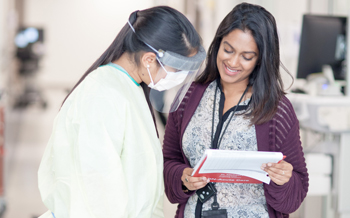Systems, software and a need for speed: An hour in the life of an influenza case

By Emily Holton

Infection preventionist Shara Junaid (right) discusses a new influenza case with an Emergency Department nurse. (Photo by Yuri Markarov)
Infection preventionist Shara Junaid is at her desk when the phone rings. It’s the hospital lab; a patient in the Emergency Department has tested positive for Influenza A.
Previously, Junaid’s next step would have been to create a case profile by opening the patient’s electronic medical record and cutting and pasting details into a new Excel spreadsheet. Today, thanks to RL6:Infection software by the Canadian company RL Solutions, the lab results have already popped up on her computer in an alert, and the patient’s details are already on her desktop when the lab calls.
Junaid is one of the infection control professionals who provide 24-7 coverage for infection prevention emergencies at St. Michael’s as well as education, surveillance and policy development. While the patient’s care team is responsible for isolating and treating the patient, the Infection Prevention and Control Team helps track and prevent an infection’s spread.
First, Junaid needs to know the patient’s basic clinical details.
“This software can pull info right away from the patient’s electronic medical record, info that we would otherwise have to find manually,” said Junaid. “We can create new profile in just a few clicks, with much less room for error.”
The patient’s history shows that he was discharged from St. Michael’s Orthopedics Ward the previous day. This means that Junaid must quickly trace the patient’s contact history to identify other patients in the ward who may have been exposed to the virus.
“We used to have to print out and manually review hospital censuses for every day the patient was in hospital and considered infectious,” said Junaid. “But now that our software is integrated with our Admission, Discharge and Transfer System, I can generate a list of previous roommates within minutes: who they were, how long they were in contact with the patient and their current location.”
About 15 minutes later, Junaid is ready to notify units which patients may have been exposed to the influenza virus. At minimum, they’ll be isolated and closely observed for the next few days.
“We’ve always had access to the lab system, the medical records system and the admission, discharge and transfer system,” said Junaid. “We had our own documentation as well, but the process of integrating and documenting all the data was time consuming. To be able to use a single program to access, pull from and generate reports from all these sources means we can investigate and act much faster.”
About St. Michael’s Hospital
St. Michael’s Hospital provides compassionate care to all who enter its doors. The hospital also provides outstanding medical education to future health care professionals in more than 29 academic disciplines. Critical care and trauma, heart disease, neurosurgery, diabetes, cancer care, care of the homeless and global health are among the Hospital’s recognized areas of expertise. Through the Keenan Research Centre and the Li Ka Shing International Healthcare Education Centre, which make up the Li Ka Shing Knowledge Institute, research and education at St. Michael’s Hospital are recognized and make an impact around the world. Founded in 1892, the hospital is fully affiliated with the University of Toronto.
